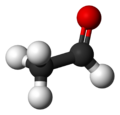Acetaldehyde
| Acetaldehyde | |
|---|---|
 
| |
| Common name | acetaldehyde |
| IUPAC name | acetaldehyde |
| Systematic name | ethanal |
| Chemical formula | C2H4O |
| SMILES | CC=O |
| Molecular mass | 44.05 g mol−1 |
| Appearance | Colorless liquid Pungent, fruity odor |
| CAS number | [75-07-0] |
| Properties | |
| Density | 0.788 g cm−3 |
| Solubility in water | soluble in all proportions |
| Melting point | −123.5 °C |
| Boiling point | 20.2 °C |
| Critical temperature | 188 °C at 6.4 MPa |
| Viscosity | ~0.215 at 20 °C |
| Structure | |
| Molecular shape | trigonal planar (sp2) at C1 tetrahedral (sp3) at C2 |
| Dipole moment | 2.7 D |
| Hazards | |
| MSDS | External MSDS |
| EU classification | Very flammable (F+) Harmful (Xn) Carc. Cat. 3 |
| NFPA 704 | |
| R-phrases | R12, R36/37, R40 |
| S-phrases | S2, S16, S33, S36/37 |
| Flash point | −39 °C |
| Autoignition temperature | 185 °C |
| RTECS number | AB1925000 |
| Supplementary data page | |
| Structure and properties |
n, εr, etc. |
| Thermodynamic data |
Phase behaviour Solid, liquid, gas |
| Spectral data | UV, IR, NMR, MS |
| Related compounds | |
| Related aldehydes | Formaldehyde Propionaldehyde Ethylene oxide |
| Disclaimer and references | |
Acetaldehyde, sometimes known as ethanal, is an organic chemical compound with the formula CH3CHO or MeCHO. It is a flammable liquid with a fruity smell. Acetaldehyde occurs naturally in ripe fruit, coffee, and fresh bread and is produced by plants as part of their normal metabolism. It is probably best known as the chemical that causes "hangovers".
In the chemical industry, acetaldehyde is used as an intermediate in the production of acetic acid, certain esters, and a number of other chemicals. In 1989, US production stood at 740 million pounds (336,000 t).[citation needed]
Ethenol
Only a trace of acetaldehyde exists as the enol form, ethenol, with Keq = 6 x 10-5.[1] Ethenol has been detected in the interstellar medium. [citation needed]
Applications in organic synthesis
Acetaldehyde is a common 2-carbon building block in organic synthesis.[2] Because of its small size and its availability as the anhydrous monomer (unlike formaldehyde), it is a common electrophile. With respect to its condensation reactions, acetaldehyde is prochiral. It is mainly used as a source of the CH3C+H(OH) synthon in aldol and related condensation reactions.[3] Grignard reagents and organolithium compounds react with MeCHO to give hydroxyethyl derivatives.[4] In one of the more spectacular condensation reactions, three equivalents of formaldehyde add to MeCHO to give pentaerythritol, C(CH2OH)4.[5]
In a Strecker reaction, acetaldehyde condenses with cyanide and ammonia to give, after hydrolysis, the amino acid alanine.[6] Acetaldehyde can condense with amines to yield imines, such as the condensation with cyclohexylamine to give N-ethylidenecyclohexylamine. These imines can be used to direct subsequent reactions like an aldol condensation.[7]
It is also an important building block for the synthesis of heterocyclic compounds. A remarkable example is its conversion upon treatment with ammonia to 5-ethyl-2-methylpyridine ("aldehyde-collidine”).[8]
Acetal derivatives
Three molecules of acetaldehyde condense to form “paraldehyde,” a cyclic trimer containing C-O single bonds; four condense to form the cyclic molecule called metaldehyde.
Acetaldehyde forms a stable acetal upon reaction with ethanol under conditions that favor dehydration. The product, CH3CH(OCH2CH3)2, is in fact called "acetal,"[9] although acetal is used more widely to describe other compounds with the formula RCH(OR')2.
Biological aspects
In the liver, the enzyme alcohol dehydrogenase converts ethanol into acetaldehyde, which is then further converted into harmless acetic acid by acetaldehyde dehydrogenase. The last steps of alcoholic fermentation in bacteria, plants and yeast involve the conversion of pyruvate into acetaldehyde by the enzyme pyruvate decarboxylase, followed by the conversion of acetaldehyde into ethanol. The latter reaction is again catalyzed by an alcohol dehydrogenase, now operating in the opposite direction.
Acetaldehyde and hangovers
Most people of East Asian descent have a mutation in their alcohol dehydrogenase gene that makes this enzyme unusually effective at converting ethanol to acetaldehyde[citation needed], and about half of such people also have a form of acetaldehyde dehydrogenase which is less effective at converting acetaldehyde to acetic acid [10]. This combination causes them to suffer from the alcohol flush reaction, in which acetaldehyde accumulates after drinking, leading to severe and immediate hangover symptoms. These people are therefore less likely to become alcoholics. The drug Antabuse (disulfiram) also prevents the oxidation of acetaldehyde to acetic acid, with the same unpleasant effects for drinkers. It has been used in the treatment of alcoholism.
Other occurrences
Acetaldehyde is an air pollutant resulting from combustion, such as automotive exhaust and tobacco smoke, contributing to the addictive properties of tobacco. [11]
Safety
Acetaldehyde is toxic, an irritant, and a probable carcinogen.[12]
ReferencesISBN links support NWE through referral fees
- ↑ March, J. “Organic Chemistry: Reactions, Mechanisms, and Structures” J. Wiley, New York: 1992. ISBN 0-471-58148-8.
- ↑ Sowin, T. J.; Melcher, L. M. ”Acetaldehyde” in Encyclopedia of Reagents for Organic Synthesis (Ed: L. Paquette) 2004, J. Wiley & Sons, New York. DOI:10.1002/047084289
- ↑ Behrens, C.; Paquette, L. A. “N-Benzyl-2,3-Azetidinedione” Organic Syntheses, Collected Volume 10, p.41 (2004)
- ↑ Walter, L. A. “1-(α-Pyridyl)-2-Propanol” Organic Syntheses, Collected Volume 3, p.757 (1955).
- ↑ Schurink, H. B. J. “Pentaerythritol” Organic Syntheses, Collected Volume 1, p.425 (1941). http://www.orgsyn.org/orgsyn/pdfs/CV1P0425.pdf
- ↑ Kendall, E. C. McKenzie, B. F. “dl-Alanine” Organic Syntheses, Collected Volume 1, p.21 (1941). http://www.orgsyn.org/orgsyn/pdfs/CV1P0021.pdf
- ↑ Wittig, G.; Hesse, A. “Directed Aldol Condensations: β-Phenylcinnamaldehyde” Organic Syntheses, Collected Volume 6, p.901 (1988).
- ↑ Frank, R. L.; Pilgrim, F. J.; Riener, E. F. “5-Ethyl-2-Methylpyridine” Organic Syntheses, Collected Volume 4, p. 451 (1963). http://www.orgsyn.org/orgsyn/pdfs/CV4P0451.pdf
- ↑ Adkins, H.; Nissen, B. H. “Acetal” Organic Syntheses, Collected Volume 1, p.1 (1941).http://www.orgsyn.org/orgsyn/pdfs/CV1P0001.pdf
- ↑ Xiao Q, Weiner H, Crabb DW (1996). The mutation in the mitochondrial aldehyde dehydrogenase (ALDH2) gene responsible for alcohol-induced flushing increases turnover of the enzyme tetramers in a dominant fashion. J. Clin. Invest. 98 (9): 2027-32.
- ↑ Smoking. (2006). Encyclopædia Britannica. Accessed 27 Oct 2006.
- ↑ http://www.epa.gov/chemfact/s_acetal.txt
See also
- Wine fault
External links
- International Chemical Safety Card 0009
- National Pollutant Inventory - Acetaldehde
- NIOSH Pocket Guide to Chemical Hazards
- IARC Monograph: "Acetaldehyde"
- EPA factsheet about acetaldehyde
- Hal Kibbey, Genetic Influences on Alcohol Drinking and Alcoholism, Indiana University Research and Creative Activity, Vol. 17 no. 3.
- United States Food and Drug Administration (FDA) information for acetaldehyde
Template:ChemicalSources
be:Ацэтальдэгід be-x-old:Ацэтальдэгід bg:Ацеталдехид cs:Acetaldehyd da:Ethanal de:Acetaldehyd et:Atseetaldehüüd el:Αιθανάλη es:Etanal fa:استالدهید fr:Éthanal gl:Acetaldehido id:Asetaldehida it:Acetaldeide la:Ethanal lv:Acetaldehīds hu:Acetaldehid nl:Aceetaldehyde ja:アセトアルデヒド no:Acetaldehyd pl:Aldehyd octowy pt:Acetaldeído ro:Acetaldehidă ru:Ацетальдегид sl:Etanal fi:Asetaldehydi sv:Acetaldehyd zh:乙醛
